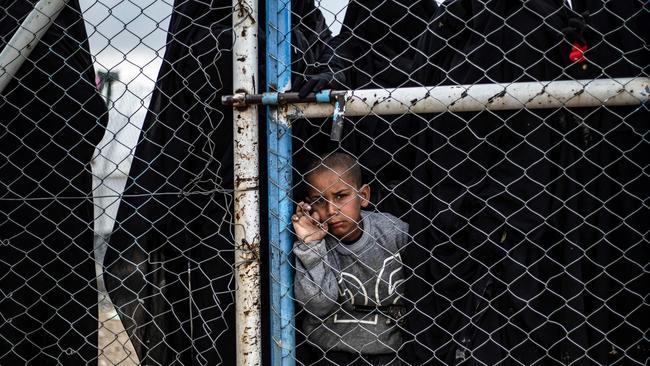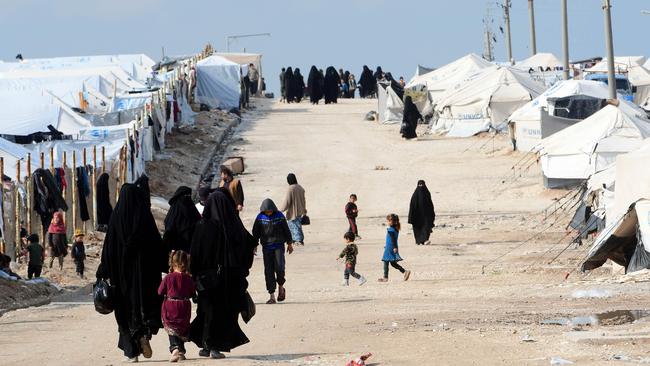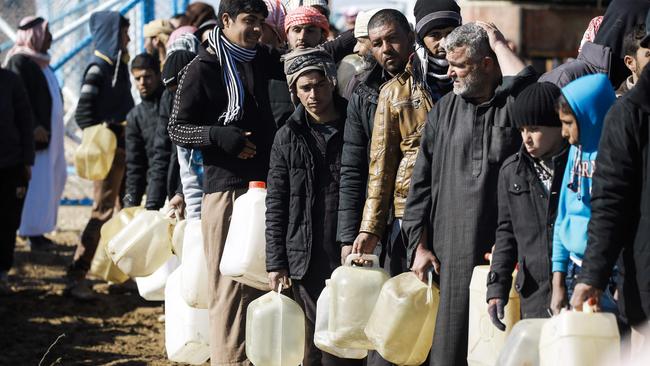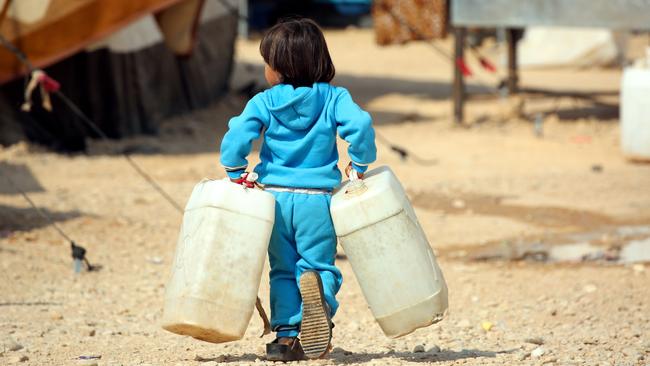Al-Hawl detention camp for ISIS families is a breeding ground for jihadists
Unjust conditions turn Syrian detention centre housing 64,000 ISIS women and children into a fetid petri dish for a new generation of jihadists.

Knife, rope, gun, fever: there are innumerable ways to die behind the wire at the al-Hawl camp. The young woman half exhumed from a shallow grave in the camp had a rope ligature around her neck, and had been strangled.
The body of another woman lying inside a tent had a single bullet wound. The corpses of four young adults - three sisters and their brother - lay side-by-side in the dust between a row of tents. All had been stabbed multiple times.
There were nine dead in all, the murder victims of the previous month in the detention camp holding more than 60,000 women and children from the defeated Islamic State.
“The security situation here is worse than it has ever been,” admitted the camp’s manager, a young Syrian Kurd in her twenties known by her title as “Havel” Amara. She scrolled through the scene-of-crime pictures from the recent murders and added: “We have more killings and more escapes than at any time. Nine murders in the past four weeks and another four wounded. The Daesh women have got silenced pistols inside the wire. We are losing control of what is happening here.”
The al-Hawl camp become infamous last year as a holding centre for the thousands of women and children who fled territory held by Islamic State when the last sliver of the group’s so-called Caliphate, in the town of Baghuz, fell. At its peak the camp held 70,000 people, from 62 nations, the majority of them family members of Isis loyalists. Among them were 34,000 children under 12 years old.

Security at al-Hawl is poor, with Isis killers able to smuggle in weapons easily.
Traffickers offer inmates passage to Turkey for about $11,000 a person.
The US, Russia, Indonesia and several smaller nations made significant efforts to repatriate their citizens held in the camp, removing 766 women and children for repatriation in 2020, but the majority of European nations - including the UK - refused to do the same.
The Kurdish-led administration, underfunded and ill equipped, and with their own security imperilled by the withdrawal of many units of US troops from Syria last year, has struggled to maintain control of the camp ever since. Now it seems to have lost the fight altogether.
Senior coalition commanders, security chiefs, local authorities and aid workers have all warned of an imminent disaster. With so many thousands kettled together in conditions described as “inhumane” by the United Nations, and with little hope of being repatriated, an inevitable chain reaction began.
Amid filthy, disease-ridden conditions, diehard remnants of Islamic State’s al-Hisbah enforcement police began to impose their discipline upon the detainees, many of whom were disillusioned with the jihadist group, or had been broken by their experience of defeat at Baghuz, and were eager to return to their homes.
The killings began. The camp authorities admit to between 30 and 35 murders in al-Hawl so far in 2020, but cannot be sure of the precise count. Some of the bodies are still hidden.
“Most of the killings are done by al-Hisbah,” said Havel Amara. She was distracted as she spoke to me: she had just learnt of another shooting of an Iraqi. “They use silenced pistols or knives. But some of the killings might be due to tribal disputes too.”
People began trying to escape from the camp. No more than a few score Isis women and their children succeeded last year, but recently the consolidation of smuggling lines, combined with more sophisticated funding, has allowed hundreds of Isis women and their families to get out. How many exactly is unknown, as there has never been a full biometric database made of the internees. Neither the camp’s true numbers nor its nationalities have ever been recorded.
“We estimate that at least 150 women and their families have escaped so far from al-Hawl this year, probably more” said Havel Amara, her voice wearied. “We do not know how many British women were among the escapees, but for sure some of the British did escape. It is a regular occurrence. Some go over the wire at night. Others use cavities in water tankers and supply vehicles. There are so many smugglers involved that the price of escape has actually decreased to around dollars 8,000 to get a woman to Turkey.”

Few escapees make it back to their home countries. Many simply disappear without trace, having made it either to Turkey or to the shelter of territory in Idlib, northern Syria, where they are looked after by other Islamist groups. At least five British women have made the journey from al-Hawl to Idlib this year, local officials say.
At least one woman who fled al-Hawl has arrived in London, with the awareness of the British authorities, under circumstances that remain unclear.
The US has tried to improve the situation, using part of a $284 million anti-Isis budget this year to help to secure detention camps and prisons in the region, but conditions in al-Hawl have worsened by the month. In January Kurdish Red Crescent officials reported that 517 people, most of them children, had died over the previous ten months in the camp. By the summer the UN said that figure had increased to more than 700 as malnutrition, drug-resistant TB and other diseases spread.
The local authorities in northeastern Syria announced this month that they would offer an amnesty to Syrians held in the camp, allowing them to return to their homes. Of approximately 64,000 people thought to be in al-Hawl, 24,300 are from Syria. According to initial plans announced by the camp’s administrators, about 3,000 Syrian families have been approved for departure, with roughly half of these expected to leave al-Hawl by the end of the year.
As a further measure, some of the 10,000 foreign detainees in the camp, the majority of whom are children, are being transferred to the smaller site at al-Roj, where security conditions and health facilities are better. Nevertheless, in the absence of any coherent repatriation plan, the camp’s generation of European and Asian children appears to have been consigned to inevitable radicalisation in deplorable conditions, for crimes they never committed.

In the interim, another killer has arrived inside the wire. Moving away from the camp, where emaciated gangs of children - Europeans, Russians, Asians, Africans and Arabs - ran feral among the tents, I entered al-Hawl’s cemetery. Here, chunks of breezeblock mark the final resting places of women and children who never made it out alive. As I watched, an ambulance arrived and disgorged a corpse wrapped in a body bag into the arms of a waiting pair of gravediggers, each dressed in full PPE.
“Coronavirus, coronavirus,” the gravediggers warned, voices muffled behind their masks, as they tumbled the body into the ground.
Analysis
It is safe to say the al-Hawl camp has surpassed Guantanamo Bay for injustice and inhumanity (Anthony Loyd writes).
European governments, reeling from a series of terrorist attacks that have enraged public opinion against any supporter of Isis, were quick to note the political capital to be gained from leaving those of their citizens who had gone to live in the caliphate penned behind the wire here indefinitely. Yet aside from fulfilling a hunger for retribution, the existence of al-Hawl and camps like it in northern Syria have done nothing to provide security for the nations who refuse to repatriate their own nationals. Rather, they have become the fetid petri dishes where a new generation of Isis followers can be created among the tens of thousands of children.
Escapes from the camps are common, and once outside the wire most of these women and their children find shelter among other Islamist groups in Idlib; perpetuating, rather than diminishing the security threat to their home nations.
Unless foreign governments grasp the problem and repatriate these children, the threat they will pose as they grow into adulthood - beyond the eyes of any authority - will far exceed the hazard they pose if they were supervised back at home.
The Times
Canonical Link: https://www.thetimes.co.uk/article/detention-camp-for-isis-families-a-breeding-ground-for-jihadists-and-coronavirus-jv9gqvgtc







To join the conversation, please log in. Don't have an account? Register
Join the conversation, you are commenting as Logout